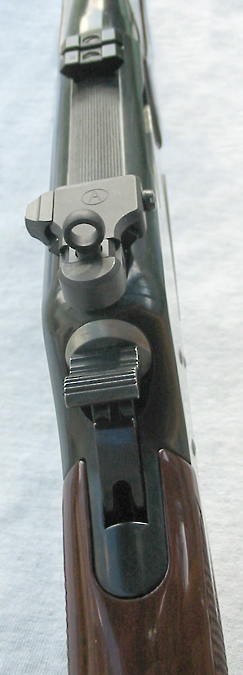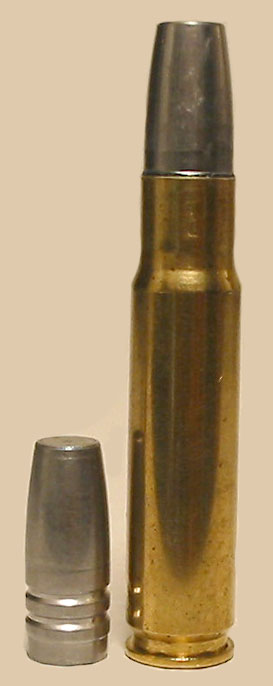They look good, just need to make up my mind and get it installed. How do you like it so far?
It has been a while since I had a chance to closely inspect the original Lyman sight this is a replica of. So I can't be sure about comparisons of manufacturing quality, etc.
I CAN say that without it, my senior citizen eyes would barely be able to use the original sights at the range, with good lighting, and a carefully chosen pair of glasses. And my eyesight isn't all THAT bad - I can drive and get through the day without glasses, as long as I don't have to do a lot of reading and the font isn't a little on the small side.
So: I love it. It gets taken for a walk regularly during hunting season. I just pick days when I decide to hunt the thicker stuff for elk and deer; the 30 Newton stays at home and the 30/40 goes hunting. This sight allows definitive use of the front sight in most reasonable ambient light conditions.
(you know you've admitted to yourself that you're an old fart when you go out in the bush when it isn't even hunting season yet to see how well you can see the sights with varying degrees of forest closure, cloudy days, etc. You start planning for EVERYTHING, just to make sure that what you think will work, actually DOES work. Remember when you just grabbed a rifle and your packboard and ran out the door at oh dark thirty to race to where you were going to hunt that day? Good times, eh!!)

The date you can barely see stamped on the frame below the sight body is 'Aug 98'. I'm not a collector, I'm a shooter, so I don't know if that has any meaning whatsoever.
I do know for sure that the reproduction does not have the dual rear aperture design with the flip down fine aperture that I have seen on the Lyman originals. I would have found that most useful for doing load development. Lacking that, I went pure Montucky.
I glued a little piece of black card stock across the rear aperture, then poked a hole through what I could best guess was the middle of the actual aperture using a Mk. 1 squinty eyeball. I found the right size ahead of time by trial and error with an assortment of dangerous sharp pointy objects. I was a little off both for elevation and windage, but I was on the butcher paper backer I was using to shoot my test groups on, so it didn't really matter. After I was done testing loads, I just pulled the card off and was back to the one and only actual rear aperture.
To actually use the rifle for it's intended purpose, hunting, the aperture the sight comes with is about right for all reasonable ambient lighting conditions. In my opinion, of course. But I have logged a LOT of time in the military and in service rifle competition shooting with aperture sights in different ambient condition. This aperture (and the width of the replacement front sight blades) are very similar to that of the service sights on my Long Branch Lee Enfield. I haven't bothered to measure, but the sight radius is almost the same for both rifles and they look very, very similar when you're behind the sights.
I'll hazard a guess here that, with a lot of experience fighting the Boer War, the Second and Third British-Afghan Wars, and two World Wars with various marks of the Lee Enfield, when they decided on what width of front sight and I.D. of rear aperture would be best for the Mk. 4 No. 1, they put a LOT of thought and testing into what combination was best for TPBI. Based on about half of my 30 years of service having aperture sights prior to the transition to optical sights, I think they got it right.
My long winded way of saying the rear aperture is about right for shooting at living things in all kinds of weather.
The original rear buckhorn got in the way of the line of sight of the aperture sight, perhaps because the rear aperture couldn't depress far enough to get a proper point of aim with the original razor blade sight. Which my eyes couldn't see well enough in many lighting conditions, particularly forest cover.
So I had my gunsmith/hunting partner remove the rear buckhorn and fill the dovetail with a metal blank. The front sight was replaced with a much thicker blade that was just high enough to get a proper zero at 200 yards, with a little bit extra to play with. Those parts went in a labeled bag and are still there for whoever the next owner of the rifle will be after I'm taking the long dirt nap. Neither my brothers nor myself ever had children, so at some point the search will have to begin to find a proper future owner of this and some other family stuff.
The second thing is, should you actually use the elevation adjustments, the hash marks on the side of the sight body and the cutsey little pointer are pretty much useless for anything resembling a return to zero, or moving to a new zero.
It would be fun to have a few new in the box examples of this rifle in 30-06, 30 U.S., and .303 British. There's at least two chamberings there that have a long history of involvement in international shooting competition. And of course the rifle takes spitzer/ball ammunition. So it would really be interesting how that long barrel and sight radius allows the rifle to shoot at 300, 400 etc yards. But this sight wasn't designed for that. My guess is the hatch marks and the cutsey brass pointer predated white wall tires as the useless sales features of their day.
I'll also guess that, after the original owners bought one of these original Lyman rear sights, they played with the adjustment a couple of times at the range throwing bullets high and low, then zeroed their rifle and never touched the adjustments again unless necessary. Reality is a cruel teacher...
But (with my rifle at least), I have once again come up with a solution that is pure Montucky engineering: a set of pocket feeler gauges.
My rear sight body sits just barely above the high point of the top of the receiver. Find out which feeler gauge fits between the underside of the sight body and the rifle receiver, and now you have your "return to zero" feature. You could do that with adjustments for different ranges, but I'm going to be pretty happy with leaving it at a 200 yard zero. Just record the gap in case the tensioning lever comes loose and the sight is suddenly adjusting itself for 1500 yards...













